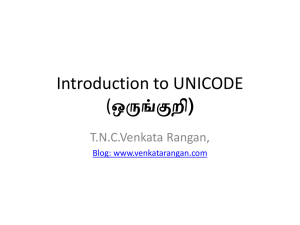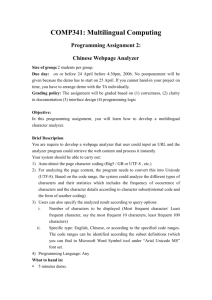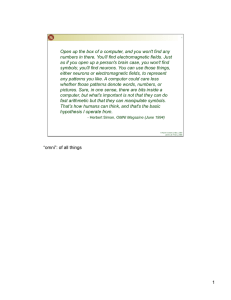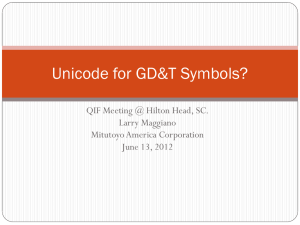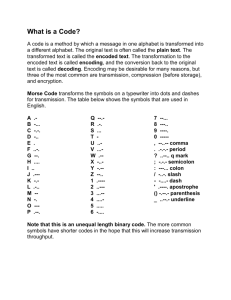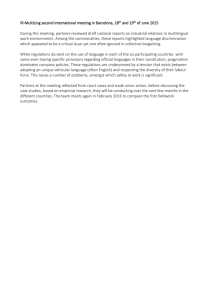INTERNATIONAL DISTRIBUTED SYSTEMS -- ARCHITECTURAL AND PRACTICAL ISSUES By Gayn B. Winters ABSTRACT
advertisement
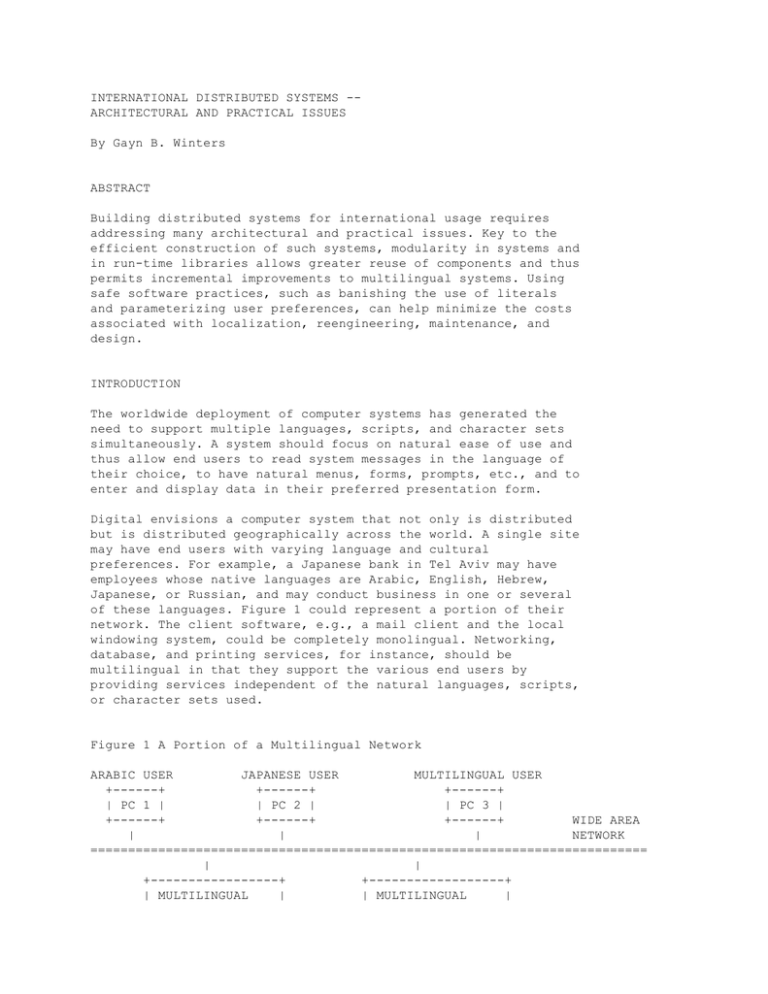
INTERNATIONAL DISTRIBUTED SYSTEMS -ARCHITECTURAL AND PRACTICAL ISSUES
By Gayn B. Winters
ABSTRACT
Building distributed systems for international usage requires
addressing many architectural and practical issues. Key to the
efficient construction of such systems, modularity in systems and
in run-time libraries allows greater reuse of components and thus
permits incremental improvements to multilingual systems. Using
safe software practices, such as banishing the use of literals
and parameterizing user preferences, can help minimize the costs
associated with localization, reengineering, maintenance, and
design.
INTRODUCTION
The worldwide deployment of computer systems has generated the
need to support multiple languages, scripts, and character sets
simultaneously. A system should focus on natural ease of use and
thus allow end users to read system messages in the language of
their choice, to have natural menus, forms, prompts, etc., and to
enter and display data in their preferred presentation form.
Digital envisions a computer system that not only is distributed
but is distributed geographically across the world. A single site
may have end users with varying language and cultural
preferences. For example, a Japanese bank in Tel Aviv may have
employees whose native languages are Arabic, English, Hebrew,
Japanese, or Russian, and may conduct business in one or several
of these languages. Figure 1 could represent a portion of their
network. The client software, e.g., a mail client and the local
windowing system, could be completely monolingual. Networking,
database, and printing services, for instance, should be
multilingual in that they support the various end users by
providing services independent of the natural languages, scripts,
or character sets used.
Figure 1 A Portion of a Multilingual Network
ARABIC USER
JAPANESE USER
MULTILINGUAL USER
+------+
+------+
+------+
| PC 1 |
| PC 2 |
| PC 3 |
+------+
+------+
+------+
WIDE AREA
|
|
|
NETWORK
==========================================================================
|
|
+-----------------+
+------------------+
| MULTILINGUAL
|
| MULTILINGUAL
|
| SERVER
|
+-----------------+
+--------------+
| MULTILINGUAL |
| DATA
|
+--------------+
| SERVER
|
+------------------+
+----------------+
| MULTILINGUAL
|
| DATA
|
+----------------+
This paper surveys many of the architectural and practical issues
involved in the efficient construction of international
distributed systems. We begin by discussing some economic issues
and pitfalls related to localization and reengineering. Many of
these topics can be addressed by straightforward good engineering
practices, and we explore several important techniques. The
structure of application-specific and system-level run-time
libraries (RTLs) is a key issue. We therefore devote several
sections of this paper to preferred RTL structures, data
representations, and key RTL services. Distributed systems cause
some special problems, which we briefly discuss, commenting on
naming, security, management, and configuration. In particular, a
desire for client software designed for monolingual distributed
systems to work without change in a multilingual distributed
system led to a new system model. In the model, the host servers
and the system management provide the interfaces and conversions
necessary for these clients to interface with the multilingual
world. Finally, we observe that all the preceding techniques can
be delivered incrementally with respect to both increasing
functionality and lowering engineering cost.
LOCALIZATION AND REENGINEERING
When a system component is productized for some local market, the
process of making it competitive and totally acceptable to that
market is called localization. During this process, changes in
the design and structure of the product may be required. These
changes are called reengineering. For example, U.S. automobiles
whose steering linkages, engine placement, console, etc., were
not designed to allow the choice of left- or right-hand steering
were not competitive in Japan. Reengineering these automobiles
for right-hand steering was prohibitively expensive, so
manufacturers had to redesign later models.
Computer systems have problems similar to the automobile
left-hand-right-hand steering problem. A good architecture and
design is necessary to avoid expensive reengineering during
localization. The following are examples of areas in which a
localization effort may encounter problems: user-defined
characters and ligatures; geometry preferences, such as vertical
or right-to-left writing direction, screen layout, and page size;
and policy differences, such as meeting protocols and required
paper trails. Building limiting assumptions into a software or
hardware product can often lead to costly reengineering efforts
and regional time-to-market delays.
On the other hand, an internal survey of reengineering problems
associated with Digital's software indicates that simple,
easy-to-avoid problems are strikingly frequent. In fact, it is
amazing how many ways a U.S. engineer could find to make use of
the (ultimately erroneous) assumption that one character fits
into one 8-bit (or even more constrictive, one 7-bit) byte!
SAFE SOFTWARE PRACTICES
Many well-known, straightforward programming practices, if
adopted, can dramatically reduce reengineering efforts.[1-7] Even
for existing systems, the cost of incrementally rewriting
software to incorporate some of these practices is often more
than recovered in lower maintenance and reengineering costs. This
section discusses a few key practices.
Probably the most fundamental and elementary safe software
practice is to banish literals, i.e., strings, characters, and
numbers, from the code. Applying this practice does not simply
redefine YES to be "yes" or THREE to be the integer 3. Rather,
this practice yields meaningful names, such as
affirmative_response and maximum_alternatives, to help anyone who
is trying to understand how the code functions. Thus, not only
does the practice make the code more maintainable, but it also
makes it easier to parameterize or generalize the data
representation, the user interface preferences, and the
functionality in ways the original programmer may have missed.
These definitions can be gathered into separate declaration
files, message catalogs, resource files, or other databases to
provide flexibility in supporting clients of different languages.
The abstraction of literals extends to many data types. In
general, it is best to use opaque data types to encapsulate
objects such as typed numbers (e.g., money and weight), strings,
date and time of day, graphics, image, audio, video, and
handwriting. Providing methods or subroutines for data type
manipulation conceals from the application how these data types
are manipulated. The use of polymorphism can serve to overload
common method and operation names like create, print, and delete.
Support for multiple presentation forms for each data type should
allow additional ones to be added easily. These presentation
forms are typically strings or images that are formatted
according to end-user preferences. Both input and output should
be factored first into transformations between the data type and
the presentation form, and then into input and output on the
presentation form. For example, to input a date involves
inputting and parsing a string that represents a presentation
form of the date, e.g., "17 janvier 1977," and computing a value
whose data type is Date.
The concepts of character and of how a character is encoded
inside a computer vary dramatically worldwide.[2,7-11] In
addition, a process that works with a single character in one
language may need to work with multiple characters in another
language. One simple rule can prevent the problems that this
variation can cause: Banish the Character data type from
applications, and use an opaque string data type instead. This
rule eliminates the tempting practice of making pervasive use of
how a character is stored and used in the programmer's native
system. The Array of Character data type is nearly as insidious,
because it is tempting to use the ith element for something that
will not make sense in another natural language. One should only
extract substrings s[i:j] from a string s. Thus, when in a given
language the object being extracted is only one code point
s[i:i], the extraction is obviously a special case. The section
Text Elements and Text Operations discusses this concept further.
Another safe software practice is to parameterize preferences, or
better yet, to attach them to the data objects. As discussed
previously, a "hardwired" preference such as writing direction
invariably becomes a reengineering problem. The language
represented by the string, the encoding type, the presentation
form of the object, and the input method for the object are all
preferences. In servers and in all kinds of databases, tagging
the data with its encoding type is desirable. In general, the
data type of the object should contain the preference attributes.
The client that processes the object can override the
preferences.
Geometry preferences should be user selectable. Some geometry
preferences affect the user's working environment, e.g., the ways
in which dialog boxes work, windows and pop-up menus cascade,
and elevator bars work.[1] These preferences are almost always
determined by the end user's working language. Other geometry
preferences relate to the data on which the user is working,
e.g., paper size, vertical versus horizontal writing (for some
Asian languages), how pages are oriented in a book, layouts for
tables of contents, and labels on graphs.
Computer programs, in particular groupware applications, mix
policy with processing. "Policy" refers to the sequence or order
of processing activities. For example, in a meeting scheduler,
can anyone call a meeting or must the manager be notified first?
Is an invoice a request for payment or is it the administrative
equivalent of delivered goods requiring another document to
instigate payment? Often such policy issues are not logically
forced by the computation, but they need to be enforced in
certain business cultures. A sequence of processing activities
that is "hardwired" into the program can be very difficult to
reengineer. Thus, policy descriptions should be placed into an
external script or database. The advent of workflow controllers,
such as those in Digital's EARS, ECHO, and TeamRoute products,
makes it easy to do this.
Applications should not put date formatting, sorting, display, or
input routines into their mainline code. Often such operations
have been coded previously, and a new application's code will
probably not be international and may well contain other bugs.
Therefore, programmers should construct applications to use, or
more precisely reuse, run-time libraries, thus investing in the
quality and the multilingual and multicultural capabilities of
these RTLs. When the underlying system is not rich enough and/or
competition dictates, the existing RTL structures must be
augmented.
RUN-TIME LIBRARY STRUCTURE
A common theme for internationalizing software and for the safe
programming practices discussed in the previous section is to
keep the main application code independent of all natural
language, script, or character set dependencies. In particular,
the code must use only RTLs with universal application
programming interfaces (APIs), i.e., the name of the routine and
its formal parameter list must accommodate all such variants.
Digital's early localization efforts typically made the mistake
of replacing the U.S.-only code with code that called RTLs
specific to the local market. This practice generated multiple
versions of the same product, each of which needed to be changed
whenever the pertinent part of the U.S. version was changed. A
better structure for run-time libraries is shown in Figure 2.
Figure 2
Modular Run-time Library Structure
+--------------------------------------------------+
|
APPLICATION
|
+--------------------------------------------------+
|
|
|
VARIOUS RUN-TIME LIBRARIES WITH UNIVERSAL
|
|
APPLICATION PROGRAMMING INTERFACES
|
|
|
+--------------------------------------------------+
| LANGUAGE 1 | LANGUAGE 2 |
| LANGUAGE N |
| RUN-TIME
| RUN-TIME
|
...
| RUN-TIME
|
| LIBRARY
| LIBRARY
|
| LIBRARY
|
+--------------------------------------------------+
The application illustrated in Figure 2 calls an RTL routine
through the routine's universal APIs. This routine may in turn
call another language-specific routine or method, or it may be
table driven. For example, a sort routine may be implemented
using sort keys rather than compare functions for better
performance. With this structure, localization to a new language
involves only the addition of the new language-specific RTL or
the corresponding new table entries.
Note that the application must pass sufficient structure to the
RTL to guarantee that the APIs are universal. For example, to
sort a list of strings, a call
sort_algorithm(list_pointer,sort_name,sort_order)
could be created. The sort_order parameter is of the type
{ascending,descending}. The sort_name parameter is necessary
because in many cultures numerous methods of sorting are
standard.[1,12] In some RTL designs, notably those specified by
X/Open Company Ltd., these extra parameters are passed as global
variables.[5,6,7] This technique has the advantage of simplifying
the APIs and making them almost identical to the APIs for the
U.S. code. Such RTLs, however, do not tend to be thread-safe and
have other problems in a distributed environment.[5,13,14] An
alternative and far more flexible mechanism is more object
oriented -- using a subtype of the List of String data type when
alternate sorts are meaningful. This subtype has the additional
information (e.g., sort_name and sort_order) used by its Sort
method.[12,14]
The next three sections discuss the organization and
extensibility of RTLs with this structure.
DATA REPRESENTATION
Data representation in RTLs incorporates text elements and text
operations, user-defined text elements, and document interchange
formats.
Text Elements and Text Operations
A text element is a component of a written script that is a unit
of processing for some text operation, such as sorting,
rendering, and substring search. Sequences of characters,
digraphs, conjunct consonants, ligatures, syllables, words,
phrases, and sentences are examples of common text
elements.[10,15] An encoded character set E represents some
particular set of text elements as integers (code points).
Typically, the range of E is extended so that code points can
represent not only text elements in multiple scripts but also
abstractions that may or may not be part of a script, such as
printing control codes and asynchronous communication codes.[16]
More complex text elements can be represented as sequences of
code points. For example, Û may be represented by two code points
<U> <^>, and a ligature such as {O joined with E} may be
represented as three code points <O> <joiner> <E>, where a
"joiner" is a special code point reserved for creating text
elements. Less complex text elements, i.e., subcomponents of the
encoded text elements, are found by using the code point and the
operation name to index into some database that contains this
information. For example, if <é> is a single code point for é,
then the base character e is found by applying some function or
table lookup to the code point <é>. The same is true for finding
a code point for the acute accent. When a sequence of code points
represents a text element, the precise term "encoded text
element" is often abbreviated as "text element."
An encoded character set of particular importance is Unicode,
which addresses the encoding of most of the world's scripts using
integers from 0 to 2**16 -1.[11, 17] The Unicode universal
character set is the basis of ISO 10646, which will extend the
code point interval to 2**31 -1 (without using the high-order
bit).[9] Unicode has a rich set of joiner code points, and it
formalizes the construction of many types of text elements as
sequences of code points.
Processing text elements that are represented as sequences of
code points usually requires a three-step process: (1) the
original text is parsed into operation-specific text elements,
(2) these text elements are assigned values of some type, and (3)
the operation is performed on the resulting sequence of values.
Note that each step depends on the text operation. In particular,
a run-time library must have a wide variety of parsing
capabilities. The following discussion of rendering, sorting, and
substring searching operations demonstrates this need.
In rendering, the text must be parsed into text elements that
correspond to glyphs in some font database. The values assigned
to these text elements are indexes into this database. The
rendering operation itself gets additional data from a font
server as it renders the text onto a logical page.
The sorting operation is more complicated because it involves a
list of strings and multiple steps. A step in most sorting
algorithms involves the assignment of collation values (typically
integers) to various text elements in each string. The parsing
step has to take into account not only that multiple code points
may represent one character but also that some languages
(Spanish, for example) treat multiple characters as one, for the
purposes of sorting. Thus, a sorting step parses each string into
text elements appropriate for the sort, assigns collation values
to these elements, and then sorts the resulting sequences of
values. Note that the parsing step that takes place in a sorting
operation is somewhat different from the one that occurs in a
rendering operation, because the sort parse must sometimes group
into one text element several characters, each of which has a
separate glyph.
Searching a string s for a substring that matches a given string
s' involves different degrees of complexity depending on the
definition of the term "matches." The trivial case is when
"matches" means that the substring of s equals s' as an encoded
substring. In this case, the parse only returns code points, and
the values assigned are the code point values. When the
definition of "matches" is weaker than equality, the situation is
more complicated. For example, when "matches" is "equal after
uppercasing," then the parsing step is the same one as for
uppercasing and the values are the code points of the uppercased
strings. (Note that uppercasing has two subtle points. The code
point for a German sharp s, <ß>, actually becomes two code points
<S><S>. Thus, sometimes the values assigned to the text elements
resulting from the parse consist of more code points than in the
original string. In addition, this substring match involves
regional preferences, for example, uppercasing a French é is E in
France and É in Canada.) The situation is similar when "matches"
equals "equal after removing all accents or similar rendering
marks." A more complex case would be when s' is a word and
finding a match in s means finding a word in s with the same root
as s'. In this case, the operation must first parse s into words
and then do a table or dictionary lookup for the values, i.e.,
the roots.
User-defined Text Elements
When the user of a system wishes to represent and manipulate a
text element that is not currently represented or manipulated by
the system, a mechanism is required to enable the user to extend
the system's capabilities. Examples of the need for such a
mechanism abound. Chinese ideograms created as new given names
and as new chemical compounds, Japanese gaiji, corporate logos,
and new dingbats are often not represented or manipulated by
standard systems.
User-defined text elements cause two separate problems. The first
problem occurs when E, the encoded character set in use, needs to
be extended so that a sequence of E's code points defines the
desired user-defined text element. The issues related to this
problem are ones of registration to prevent one user's extensions
from conflicting with another user's extensions and to allow data
interchange.
The second, more difficult problem concerns the extensions of the
text operations required to manipulate the new text element. For
each such text operation, the parsing, value mapping, and
operational steps discussed earlier must be extended to operate
on strings that involve the additional code points of E. When
tables or databases define these steps, the extensions are
tedious but often straightforward. Careful design of the steps
can greatly simplify their extensions. In some cases, new
algorithms are required for the extension. To the extent that
these tables, databases, or algorithms are shared, the extensions
must be registered and shared across the system.
Document Interchange Formats
Compound documents (i.e., documents that contain data types other
than text) use encoded character sets to encode simple text.
Although many new document interchange formats (DIFs) will
probably use Unicode exclusively (as does Go Computer
Corporation's internal format for text), existing formats should
treat Unicode as merely another encoded character set with each
character set being tagged.[18] This allows links to be made to
existing documents in a natural way.
Many so-called revisable DIFs, such as Standard Generated Mark-up
Language (SGML), Digital Document Interchange Format (DDIF),
Office Document Architecture (ODA), Microsoft Rich Text Format
(RTF), and Lotus spreadsheet format (WKS), and page description
languages (PDLs), such as PostScript, Sixels, or X.11, can be
extended to provide this Unicode support by enhancing the
attribute structure and extending the text import map
Strings(E)-->DIF for each encoded character set E. In doing so,
however, many of the richer constructs in Unicode, e.g., writing
direction, and many printing control codes are often best
replaced with the DIF's constructs used for these features
instead.[19] In this way, both processing operations are easier
to extend and facilitate the layout functions DIF-->PDL and the
rendering functions PDL-->Image.
PRESENTATION SERVICES
The practice of factoring input and output of data types into a
transformation T<-->T_Presentation_Form and performing the I/O on
the presentation form allows one to focus on each step
separately. This factorization also clarifies the applicability
of various user preferences, e.g., a date form preference applies
to the transformation, and a font preference applies to how the
string is displayed. As mentioned in the section Safe Software
Practices, preferences such as presentation form are best
attached to the end user's copy of the data. Data types such as
encoded image, encoded audio, and encoded video pose few
international problems except for the exchangeability of the
encodings and the viability of some algorithms for recognizing
speech and handwriting. Algorithms for presentation services can
be distributed, but we view them as typically residing on the
client.[20] In Figure 1, we presume that the local language PCs
have this capability.
Input
Existing technology offers several basic input services, which
are presented in the following partial list of device-data type
functions:
o
Keystrokes-->Encoded Character
o
Image-->Encoded Image
o
Audio Signal-->Encoded Audio
o
Video Signal-->Encoded Video
o
Handwriting-->Encoded Handwriting
The methods for each input service depend on both the device and
the digital encoding and often use multiple algorithms. Whereas
for some languages the mapping of one or more keystrokes into an
encoded character (e.g., [compose] + [e] + [/] yielding é) may be
considered mundane, input methods for characters in many Asian
languages are complex, fascinating, and the topic of continuing
research. The introduction of user-defined text elements, which
is more common among the Asian cultures, requires these input
methods to be easily extendable to accommodate user-defined
characters.
Output
The basic output services are similar to the input services
listed in the previous section.
o
Strings-->Image
o
DIF-->PDL-->Image
o
Encoded Image-->Image
o
Encoded Audio-->Audio Signal
o
Encoded Video-->Video Signal
o
Encoded Handwriting-->Image
These output services also vary with encoding, device, and
algorithm. Figure 3 illustrates the sequence DIF-->PDL-->Image.
Optional parameters are permitted at each step. A viable
implementation of Strings-->Image is to factor this function by
means of the function Strings-->DIF, which is discussed in the
Data Representation section. Alternatively, the data type Strings
can be simply viewed as another DIF to be supported.
Figure 3 Layout and Rendering Services
+-----------+
+-----------+
| PARAMETER |
| PARAMETER |
+-----------+
+-----------+
|
|
V
V
+-------------+
+--------+
+-------------+
+--------+
+-------+
| DOCUMENT
|
|
|
| PAGE
|
|
|
|
|
| INTERCHANGE |-->| LAYOUT |-->| DESCRIPTION |-->| RENDER |-->| IMAGE |
| FORMAT
|
|
|
| LANGUAGE
|
|
|
|
|
+-------------+
+--------+
+-------------+
+--------+
|
|
+----------+
+-------------+
|
|
+-------------+
| FONT SERVER |
+-------------+
+-------+
+----------+
| FONT
|
| DATABASE |
+----------+
A revisable document begins in some DIF such as plain text,
Strings(Unicode), SGML, or DDIF. A layout process consumes the
document and some logical page parameters and creates an
intermediate form of the document in some PDL such as PostScript,
Sixels, or even a sequence of X.11 packets. To accomplish this,
the layout process needs to get font metrics from the font server
(to compute relative glyph position, word and line breaks, etc.).
In turn, the rendering process consumes the PDL and some physical
media parameters to create the image that the end user actually
sees. The rendering process may need to go back to the font
server to get the actual glyphs for the image. Rendering, layout,
and font services are multilingual services. The servers for
these services are the multilingual servers envisioned in Figure
1.
COMPUTATION SERVICES
To build systems that process multilingual data, such as the one
shown in Figure 1, a rich variety of text operations is
necessary. This section categorizes such operations, but a
complete specification of their interfaces would consume too much
space in this paper. Text operations require parsing, value
mapping, and operational functions, as described earlier.
Text Manipulation Services
Text manipulation services, such as those specified in C
programming language standard ISO/IEC 9899:1990, System V Release
4 Multi-National Language Supplement (MNLS), or XPG4 run-time
libraries (including character and text element classification
functions, string and substring operations, and compression and
encryption services) need to be extended to multilingual strings
such as Strings(Unicode) and other DIFs, and to various text
object class libraries.[6,8,13]
Data Type Transformations
Data type transformations (e.g., speech to text, image-to-text
optical character recognition [OCR], and handwriting to text) are
operations where the data is transformed from a representation of
one abstract data type to a representation of another abstract
data type. The presentation form transformations
T<-->T_Presentation_Form and the fundamental input and output
services are data type transformations. Care needs to be taken
when parameterizing these operations with user preferences to
keep the transformation thread-safe. Again, this is best
accomplished by keeping the presentation form preferences
attached to the data.
Encoding Conversions
Encoding conversions (between encoded character sets, DIFs, etc.)
are operations where only the representation of a single data
type changes. For example, to support Unicode, a system must have
for each other encoded character set a function
to_uni:Strings(E)-->Strings(Unicode), which converts the code
points in E to code points in Unicode.[11] The conversion
function to_uni has a partial inverse
from_uni:Strings(Unicode)-->Strings(E), which is only defined on
those encoded text elements in Unicode that can be expressed as
encoded text elements in E. If s is in Strings(E), then
from_uni(to_uni(s)) is equal to s. Other encoding conversions
Strings(E)-->Strings(E') can be defined as a to_uni operation
followed by a from_uni operation, for E and E' respectively.
Another class of encoding conversions arises when the character
set encoding remains fixed, but the conversion of a document in
one DIF to a document in another DIF is required. A third class
originates when Unicode or ISO 10646 strings sent over
asynchronous communication channels must be converted to a
Universal Transmission Format (UTF), thus requiring
Strings(Unicode)<-->UTF encoding conversions.
Collation or Sorting Services
Another group of computation services, collation or sorting
services, sorts lists of strings according to
application-specific requirements. These services were discussed
earlier in the paper.
Linguistic Services
Linguistic services such as spell checking, grammar checking,
word and line breaking, content-based retrieval, translation
(when existent), and style checking need standard APIs. Although
the implementation of these linguistic services is natural
language-specific, most can be implemented with the structure
shown in Figure 2.
Also, large character sets such as Unicode and other multilingual
structures require a uniform exception-handling and fallback
mechanism because of the large number of unassigned code points.
For example, a system should be able to uniformly handle
exceptions such as "glyph not found for text element." Mechanisms
such as global variables for error codes inhibit concurrent
programming and therefore should be discouraged. Returning an
error code as the return value of the procedure call is
preferred, and when supported, raising and handling exceptions is
even better.
SYSTEM NAMING, SYNONYMS, AND SECURITY
The multilingual aspect of Unicode can simplify system naming of
objects and their attributes, e.g., in name services and
repositories. Using encoded strings tagged with their encoding
type for names is too rigid, because of the high degree of
overlap in the various encoded character sets. For example, the
string "ABC" should represent one name, independent of the
character set in which the string is encoded. Two tagged strings
represent the same name in the system if they have the same
canonical form in Unicode according to the following definitions.
Unicode has the property that two different Unicode strings, u
and v, may well represent the same sequence of glyphs when
rendered.[11] To deal with this, a system can define an internal
canonical form c(u) for a Unicode string u. c(u) would expand
every combined character in u to its base characters followed by
their assorted marking characters in some prescribed order. The
recommended order is the Unicode "priority value."[11,21] The
canonical form should have the following property: When c(u) is
equal to c(v), the plain text representations of u and v are the
same. Ideally, the converse should hold as well.
Thus, u and v represent the same name in the system if c(u) is
equal to c(v). In any directory listing, an end user of a
language sees only one name per object, independent of the
language of the owner who named the object. Further restrictions
on the strings used for names are desirable, e.g., the absence of
special characters and trailing blanks. In a multivendor
environment, both the canonical form and the name restrictions
should be standardized. The X.500 working groups currently
studying this problem plan to achieve comparable standardization.
Since well-chosen names convey useful information, and since such
names are entered and displayed in the end user's writing system
of choice, it is often desirable for the system to store various
translations or "synonyms" for a name. Synonyms, for whatever
purpose, should have attributes such as long_name, short_name,
language, etc., so that directory functions can provide
easy-to-use interfaces. Access to objects or attribute values
through synonyms should be as efficient as access by means of the
primary name.
In a global network, public key authentication using a replicated
name service is recommended.[22] One principal can look up
another in the name service by initially using a (possibly
meaningless) name for the object in some common character set,
e.g., {A-Z,0-9}. Subsequently, the principals can define their
own synonyms in their respective languages. Attributes for the
principals, such as network addresses and public encryption keys,
can then be accessed through any synonym.
SYSTEM MANAGEMENT AND CONFIGURATION
The system management of a multilingual distributed system is
somewhat more complicated than for a monolingual system. The
following is a partial list of the services that must be
provided:
o
Services for various monolingual subsystems
o
Registration services for user preferences, locales,
user-defined text elements, formats, etc.
o
Both multilingual and multiple monolingual run-time
libraries, simultaneously (see Figure 2)
o
Multilingual database servers, font servers, logging and
queuing mechanisms, and directory services
o
Multilingual synonym services
o
Multilingual diagnostic services
Since a system cannot provide all the services for every
possible situation, registering the end users' needs and the
system's capabilities in a global name service is essential. The
name service must be configured so that a multilingual server can
identify the language preferences of the clients that request
services. This configuration allows the servers to tag or convert
data from the client without the monolingual client's active
participation. Therefore, the name service database must be
updated with the necessary preference data at client installation
time.
Typically, system managers for different parts of the system are
monolingual end users (see Figure 1) who need to do their job
from a standard PC. Thus, both the normal and the diagnostic
management interfaces to the system must behave as multilingual
servers, sending error codes back to the PC to be interpreted in
the local language. Although the quality of the translation of an
error message is not an architectural issue, translations at the
system management level are generally poor, and the system design
should account for this. Systems developers should consider
giving both an English and a local-language error message as well
as giving easy-to-use pointers into local-language reference
manuals.
Data errors will occur more frequently because of the mixtures of
character sets in the system, and attention to the identification
of the location and error type is important. Logging to capture
offending text and the operations that generated it is desirable.
INCREMENTAL INTERNATIONALIZATION
Multilingual systems and international components can be built
incrementally. Probably the most powerful approach is to provide
the services to support multiple monolingual subsystems. Even new
operating systems, such as the Windows NT system, that use
Unicode internally need mechanisms for such support.[23]
Multidimensional improvements in a system's ability to support an
increasing number of variations are possible. Some such
improvements are making more servers multilingual, supporting
more multilingual data and end-user preferences, supporting more
sophisticated text elements (the first release of the Windows NT
operating system will not support Unicode's joiners), as well as
adding more character set support, locales, and user-defined text
elements. The key point is that, like safe programming practices,
multilingual support in a distributed system is not an
"all-or-nothing" endeavor.
SUMMARY
Customer demand for multilingual distributed systems is
increasing. Suppliers must provide systems without incurring the
costs of expensive reengineering. This paper gives an overview of
the architectural issues and programming practices associated
with implementing these systems. Modularity both in systems and
in run-time libraries allows greater reuse of components and
incremental improvements with regard to internationalization.
Using the suggested safe software practices can lower
reengineering and maintenance costs and help avoid costly
redesign problems. Providing multilingual services to monolingual
subsystems permits incremental improvements while at the same
time lowers costs through increased reuse. Finally, the
registration of synonyms, user preferences, locales, and services
in a global name service makes the system cohesive.
ACKNOWLEDGMENTS
I wish to thank Bob Ayers (Adobe), Joseph Bosurgi (Univel), Asmus
Freytag (Microsoft), Jim Gray (Digital), and Jan te Kiefte
(Digital) for their helpful comments on earlier drafts. A special
thanks to Digital's internationalization team, whose
contributions are always understated. In addition, I would like
to acknowledge the Unicode Technical Committee, whose impact on
the industry is profound and growing; I have learned a great deal
from following the work of this committee.
REFERENCES
1.
D. Carter, Writing Localizable Software for the
Macintosh (Reading, MA: Addison-Wesley, 1991).
2.
Producing International Products (Maynard, MA: Digital
Equipment Corporation, 1989). This internal document is
unavailable to external readers.
3.
Digital Guide to Developing International Software
(Burlington, MA: Digital Press, 1991).
4.
S. Martin, "Internationalization Made Easy," OSF White Paper
(Cambridge, MA: Open Software Foundation, Inc., 1991).
5.
S. Snyder et al., "Internationalization in the OSF DCE -- A
Framework," May 1991. This document was an electronic mail
message transmitted on the Internet.
6.
X/Open Portability Guide, Issue 3 (Reading, U.K.: X/Open
Company Ltd., 1989).
7.
X/Open Internationalization Guide, Draft 4.3 (Reading, U.K.:
X/Open Company Ltd., October 1990).
8.
UNIX System V Release 4, Multi-National Language Supplement
(MNLS) Product Overview (Japan: American Telephone and
Telegraph, 1990).
9.
Information Technology -- Universal Coded Character Set
(UCS) Draft International Standard, ISO/IEC 10646 (Geneva:
International Organization for Standardization/International
Electrotechnical Commission, 1990).
10.
A. Nakanishi, Writing Systems of the World, third printing
(Rutland, Vermont, and Tokyo, Japan: Charles E. Tuttle
Company, 1988).
11.
The Unicode Consortium, The Unicode Standard -- Worldwide
Character Encoding, Version 1.0, Volume 1 (Reading, MA:
Addison-Wesley, 1991).
12.
R. Haentjens, "The Ordering of Universal Character Strings,"
Digital Technical Journal, vol. 5, no. 3 (Summer 1993):
43-52.
13.
Programming Languages -- C, ISO/IEC 9899:1990(E) (Geneva:
International Organization for Standardization/International
14.
Electrotechnical Commission, 1990).
S. Martin and M. Mori, Internationalization in OSF/1 Release
1.1 (Cambridge, MA: Open Software Foundation, Inc., 1992).
15.
J. Becker, "Multilingual Word Processing," Scientific
American, vol. 251, no. 1 (July 1984): 96-107.
16.
Coded Character Sets for Text Communication, Parts 1 and
2, ISO/IEC 6937 (Geneva: International Organization for
Standardization/International Electrotechnical Commission,
1983).
17.
J. Bettels and F. Bishop, "Unicode: A Universal Character
Code," Digital Technical Journal, vol. 5, no. 3 (Summer
1993): 21-31.
18.
Go Computer Corporation, "Compaction Techniques,"
Second Unicode Implementors' Conference (1992).
19.
J. Becker, "Re: Updated [Problems with] Unbound (Open)
Repertoire Paper" (January 18, 1991). This electronic mail
message was sent to the Unicode mailing list.
20.
V. Joloboff and W. McMahon, X Window System, Version 11,
Input Method Specification, Public Review Draft (Cambridge,
MA: Massachusetts Institute of Technology, 1990).
21.
M. Davis, (Taligent) correspondence to the Unicode Technical
Committee, 1992.
22.
M. Gasser et al., "Digital Distributed Security
Architecture" (Maynard, MA: Digital Equipment Corporation,
1988). This internal document is unavailable to external
readers.
23.
H. Custer, Inside Windows NT (Redmond, WA: Microsoft Press,
1992).
TRADEMARKS
Digital and TeamRoute are trademarks of Digital Equipment
Corporation.
PostScript is a registered trademark of Adobe Systems Inc.
Windows NT is a trademark of Microsoft Corporation.
BIOGRAPHY
Gayn B. Winters Corporate consulting engineer Gayn Winters has
25 years' experience developing compilers, operating systems,
distributed systems, and PC software and hardware. He joined
Digital in 1984 and managed the DECmate, Rainbow, VAXmate, and PC
integration architecture. He was appointed Technical Director for
Software in 1989 and contributes to the Corporate software
strategy. From 1990 to 1992, Gayn led the internationalization
systems architecture effort and is on the Board of Directors for
Unicode, Inc. He has a B.S. from the University of California at
Berkeley and a Ph.D. from MIT.
=============================================================================
Copyright 1993 Digital Equipment Corporation. Forwarding and copying of this
article is permitted for personal and educational purposes without fee
provided that Digital Equipment Corporation's copyright is retained with the
article and that the content is not modified. This article is not to be
distributed for commercial advantage. Abstracting with credit of Digital
Equipment Corporation's authorship is permitted. All rights reserved.
=============================================================================

